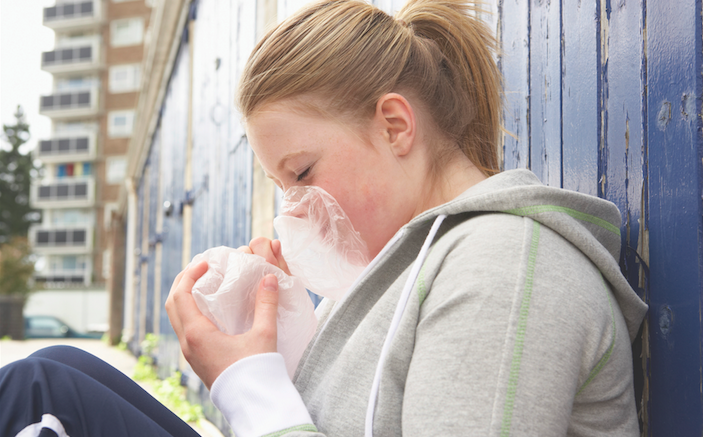Know what to expect in patients who abuse inhalants by huffing, sniffing or bagging.
Inhalant abuse refers to inhalation of volatile vapors with the intention of inducing a state of euphoria or intoxication. While the effects are generally short-lived, acute use can sometimes cause seizures, hallucinations, or even “sudden sniffing death.” As with many other illicit drugs, inhalant use can also lead to disinhibition, with the associated poor judgement and potentially injurious behavior that may end in an ED visit. Chronic use can lead to problems such as anemia, hypokalemia, and acidosis. Here is a little background on inhalants, and some tips to help you identify patients who may have abused them.
Mechanism and Use: Inhalants are volatile chemicals, usually hydrocarbons, that can be delivered to the airways through several different mechanisms. They can be inhaled directly, such as breathing in over an open solvent container, known as “sniffing”. Alternatively, the material can be sprayed into a bag and then inhaled by holding it over the mouth or, more dangerously, by placing the bag over the head, called “bagging”. Bagging is used for sprays and aerosol products, including non-stick cooking spray, hairspray, or whipped cream spray cans. Finally, the material can be inhaled from a cloth that is soaked in the hydrocarbon by holding it over the nose or mouth, known as “huffing”. Volatile hydrocarbons are very lipophilic, so easily cross the pulmonary lining and get into the bloodstream. They act directly on neurons and cause CNS depression, most likely through altered GABA and glutamate activity [1].
Epidemiology and History: 11% of high school students reported using an inhalant at some time [2], though over 80% of high school students say they would “disapprove of even trying an inhalant” [3]. Rates of use are similar in male and female teenagers [4]. Previously inhalant use was more common in rural areas, but now rates are similar in rural and urban areas. Inhalant use was associated with the punk youth culture of the 1970s, with a number of references to it in punk music. Use peaked in 1995, then started to drop 3 off, but has increased gradually again since 2002 . The most frequently abused substances are inhalants (toluene, glue, shoe polish), gasoline, lighter fluid, nitrous oxide, and spray paint [5].
Signs and Symptoms: The typical effects of hydrocarbon abuse, including intoxication, euphoria, and lightheadedness last a brief 15-30 minutes [6], though effects can be lengthened with continued use. CNS depression, confusion, seizures, hallucinations, and neuropathy can occur but are also typically short-lived. With chronic use, there can be longer term effects, including neurocognitive impairment, neuropathies, and cerebellar dysfunction thought to be due to toxic leukoencephalopathy, or degeneration of the white matter.
Death or acute injury typically occurs through mechanisms other than direct effects of the inhaled chemicals, including:
Asphyxiation: This can occur particularly with “bagging”.
Intoxication-related Injuries: Vomiting and aspiration can occur as with intoxication by other agents. Also, intoxicated individuals are disinhibited and may engage in potentially injurious or risky behavior.
Sudden Sniffing Death: This is a rare form of sudden cardiac death seen more often with halogenated hydrocarbons, which include freons, carbon tetrachloride, and other chemicals found in solvents, refrigerants, and fire extinguishers. It occurs typically with use of the hydrocarbon, and then exertion or sexual stimulation, and is thought to be due to increased catecholamine release as well as some hypoxia from the inhalant and sensitization of the myocardium, leading to dysrhythmias. It can occur even with 1st time users.
Chronic use can cause disorders specific to the agent abused. For example:
- Nitrites can cause methemoglobinemia.
- Nitrous oxide, though not a hydrocarbon, is usually considered along with the other inhalants, and can cause neuropathies and macrocytic anemia due to inactivation of B12.
- Toluene can cause weakness, hypokalemia, and acidosis.
- Gasoline can cause myopathies and elevated CK.
- Octane additives in gasoline can lead to parkinsonism.
- Though no longer common in the United States, leaded gasoline can cause lead toxicity.
While it may be difficult to identify patients who have abused inhalants unless they provide that history, there are some clues that you may see. Chronic inhalant users may have a “glue sniffer’s rash” on the nose and mouth. The smell of solvents on their skin or clothing is also a giveaway sign. If a young patient presents with ataxia or slurred speech that quickly resolves, potentially with wheezing or initial hypoxia that can also be a clue to inhalant use.
Management: Patients with severely depressed mental status may require supplemental oxygen or intubation, along with a workup for other reversible causes of altered mental status, including hypoglycemia, opioid use, infection, trauma, or other intoxicants. An EKG may be useful to identify dysrhythmias or QT variability (QT dispersion), a marker of abnormal repolarization seen with chronic toluene use. A BMP and CK should be obtained if there is any muscle weakness. Hypokalemia from toluene abuse will need careful potassium repletion, with monitoring of electrolytes, pH, calcium, and phosphorus. Patients should also be assessed for depression, suicidality, or other substance use disorders, and referred for further substance abuse treatment when possible.
REFERENCES
- Perry H. Inhalant abuse in children and adolescents. UptoDate. 2014.
- Eaton DK, Kann L, Kinchen S, et al. Youth risk behavior surveillance – united states, 2011. MMWR Surveill Summ. 2012;61(4):1-162.
- Johnston L, O’Malley P, Bachman J, Schulenberg J. Monitoring the future national results on adolescent drug abuse: Overview of key findings, 2010. http://www.monitoringthefuture.org/pubs/monographs/mtf-overview2010.pdf. Published 2011. Accessed 05/17, 2016.
- Substance Abuse and Mental Health Services Administration Office of Applied Studies. Results from the 2007 national survey on drug use and health: National findings. NSDUH Series H-34, DHHS Publication No , SMA 08-4343. 2008(Rockville, MD).
- Dinwiddie SH. Abuse of inhalants: A review. Addiction. 1994;89(8):925-939.
- Brust JC. Other agents. phencyclidine, marijuana, hallucinogens, inhalants, and anticholinergics. Neurol Clin. 1993;11(3):555-561.



